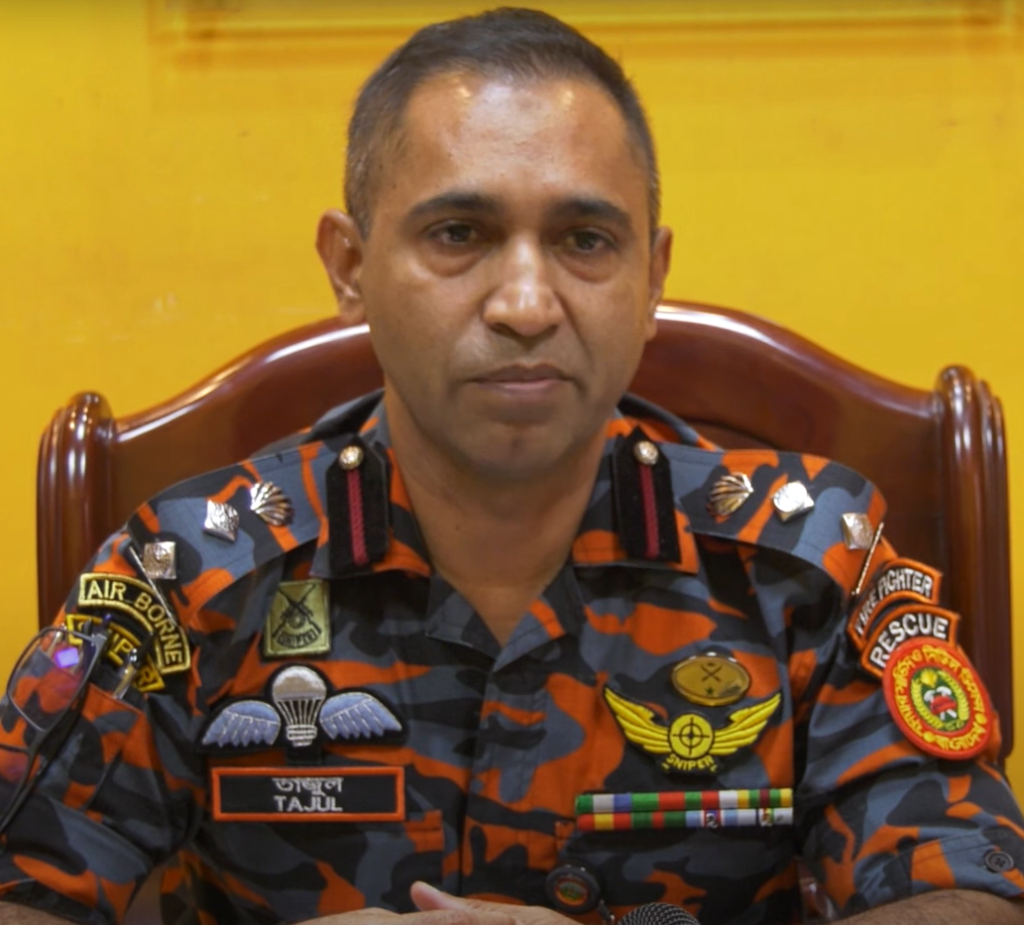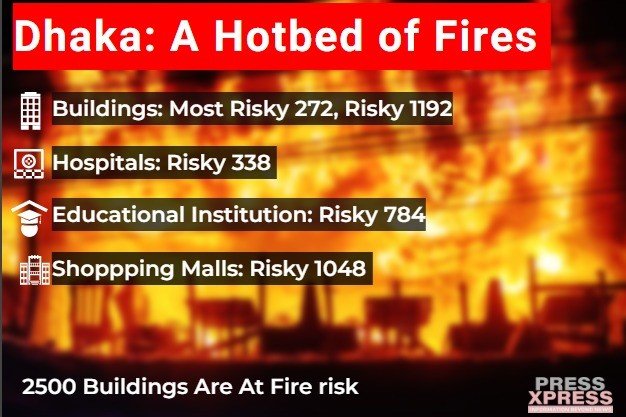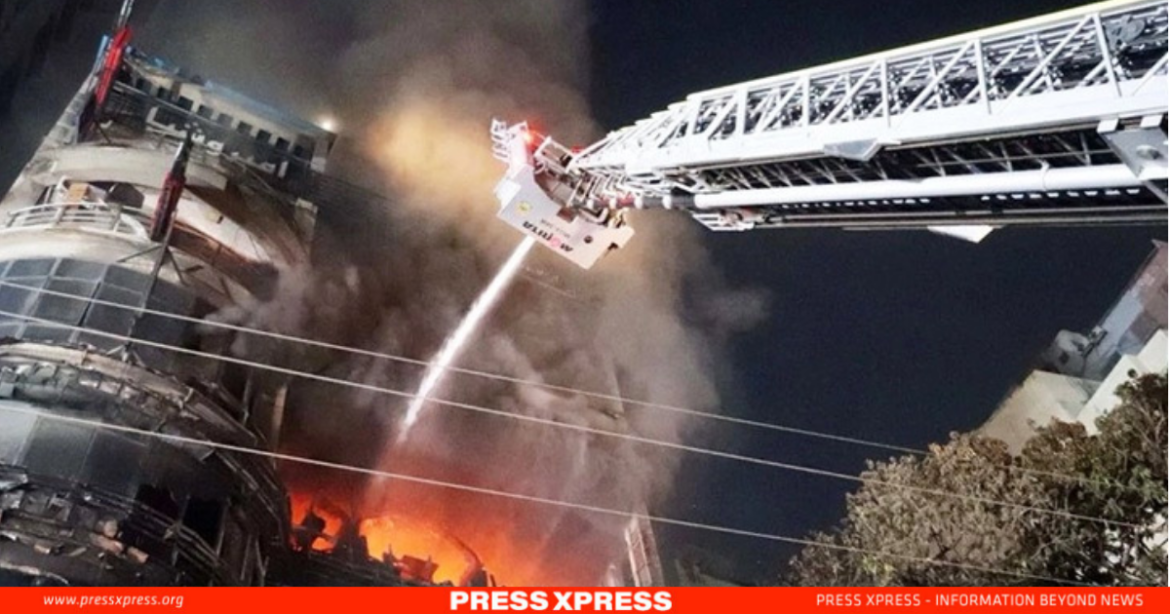Dhaka, the capital city of Bangladesh, is one of the fastest-growing megacities in the world. But beneath its vibrant and dynamic surface, more than 20 million city dwellers are facing an immense dark and deadly secret: thousands of buildings that are ticking firebombs, waiting to erupt into flames at any moment. These risk factors have been generated over the violation of the national building codes. Expert says the lack of proper fire safety measures, poses a grave threat to the lives and livelihoods of millions of residents.
During drives, we found the owners not abiding by the rules in most cases. The fire service had the jurisdiction to impose fines and seal off buildings according to Fire Prevention and Extinguishing Act, 2003. However, now they have little scope to do that following the repletion of the concerned provision
– Tazul Islam Chowdhury, director (operation and maintenance), fire service

After the tragic fire incident at Bailey Road in Dhaka, which claimed the lives of at least 46 individuals, the subject of fire safety has catapulted again to the forefront of concerns among city dwellers. Official reports from the Fire Service indicate that a staggering 2,512 buildings within Dhaka city are categorized as ‘Most Risky,’ effectively rendering them potential fires. This alarming figure includes 1,048 marketplaces and shopping centers, with the remainder comprising hospitals, residential hotels, educational establishments, and media outlets.
You can also read: Deputy Commissioners to Scrap Food Hoarding, Implementation Building Codes
Despite repeated warnings issued by the Fire Service, compliance among building owners remains tame. Even the building that burned on Bailey Road has received three warnings from the fire service. Recently, both Bangabazar Complex Market and Mohammadpur Krishi Market were issued warning letters regarding fire safety, but unfortunately, no significant improvements were observed.
Fire Service Inspections
Throughout 2023, the Fire Service conducted inspections of 1,048 markets and 345 hospitals. Regrettably, only 7 hospitals met proper fire safety standards. The remaining 338 hospital buildings continue to operate, despite the fire hazards present. Within this group, 120 buildings are classified as high risk and 218 as moderate risk.
In Dhaka, fire safety measures were adequate in only 7 out of 325 residential hotels. Among the remaining 318 hotels, 70 are considered high risk and 248 are deemed vulnerable. Similarly, of the 801 educational institutions inspected—including schools, colleges, and universities—only 17 were up to fire safety codes. The rest, numbering 784, are not compliant, with 64 categorized as very high risk and 720 as at risk.
Moreover, an assessment of 26 media houses in the capital revealed that 18 are at a very high risk of fire, and 6 are categorized as dangerous.

Risky markets and shopping malls in Dhaka
According to the Fire Service, among the markets in Dhaka, 118 buildings were inspected in the areas of Gulshan, Banani, Bashundhara, Baridhara, Badda, Bhatara, and Kuril. Of these, 79 buildings were identified as extremely risky and 34 as risky. In the areas of Wari, Gulistan, Paltan, Shahbagh, Bangshal, Kakrail, Bailey Road, BCC Road, and Shantinagar, 104 buildings were inspected. There, 12 buildings were marked as very risky and 90 as risky. In Mirpur, Pallabi, Kazipara, Sheorapara, Darussalam, and Kafrul, 126 buildings were inspected. During this time, 64 buildings were identified as very risky and 58 as risky in those areas. In Jatrabari, Shyampur, Kadamtali, and South Keraniganj, all 89 inspected buildings were marked as risky.
In the capital’s Moghbazar, Tejgaon, Mohakhali, and Karwan Bazar areas, 55 buildings were inspected, with 31 identified as extremely risky and 24 as risky. In Khilkhet, Nikunja, and surrounding areas, 90 buildings were inspected and 55 were considered risky. In Lalmatia, Jigatola, Dhanmondi, Kalabagan, Green Road, Mohammadpur, and Shyamoli, 74 buildings were inspected, with 15 identified as very risky and 58 as risky. In Demra, Sarulia, Malibagh, Khilgaon, East Rampura, and Mugda, all 150 inspected buildings were found to be risky, including 10 that were extremely risky. In Chawkbazar, Lalbagh, New Market, and Elephant Road areas, 100 buildings were inspected, with 88 marked as very risky and 12 as risky. In Sadarghat, Islampur, Laxmibazar, Patuatuli, and surrounding areas, all 142 inspected buildings were identified as risky.
Additionally, in various areas of Dhaka’s Savar, Ashulia, and Tongi, 143 buildings were inspected, with 93 identified as very risky and 50 as risky.
Why These Buildings Are at Risk
Fire Service officials say that the risky buildings lack fire safety equipment. There are no arrangements for water reservoirs or water retention as per regulations in these buildings. Even the surrounding areas lack water facilities. Moreover, many buildings have limited access to Fire Service water tankers.
Additionally, the buildings have substandard electrical equipment, improperly hung or unsafe electrical transmission lines, no fire safety management as per building codes, blocked access by closing doors and windows beyond the building’s design, or by constructing new structures that obstruct passage, and lack of necessary staircases and elevators for use during fire emergencies, leading to their classification as fire risks.
Taking Advantage of Loopholes in The Law
Many building owners do not comply with fire safety regulations, taking advantage of the conflicting legal definitions of a high-rise building. According to the Building Construction Rules 2008 and the Bangladesh National Building Code, buildings taller than 10 stories or 33 meters are considered high-rise.
However, the Fire Prevention Act defines any establishment over six stories as a high-rise. Owners of buildings over six stories must obtain a No Objection Certificate (NOC) from the Fire Service and Civil Defence.
Adil Mohammad Khan, President of the Bangladesh Institute of Planners, says, “But many owners do not want to get an NOC because it is not mandatory for buildings under 10 stories as per the construction rules.”
He also says that due to the lack of a uniform definition of a high-rise building, many buildings between seven to ten stories, especially residential ones, lack two staircases and fire extinguishing equipment. Owners only obtain approval from the RAJUK, which does not recognize these buildings as high-rise.
Adil says that having multiple staircases and other safety measures is also not mandatory for these buildings. It is crucial to have a uniform definition of a high-rise building because it determines whether a building should have multiple staircases, emergency elevators, sprinklers, fire-resistant doors, adequate fire extinguishers, and water reservoirs.
Moreover, any building used for commercial purposes must have fire extinguishing arrangements from the Fire Service. The Director-General of the Fire Service issues NOCs based on occupancy. According to him, many commercial building owners receive NOCs. But once they get it, they forget about the safety plan. ‘They just keep some fire extinguishers and hose reels, but do not implement other aspects of the plan.
Major Fire Incidents



